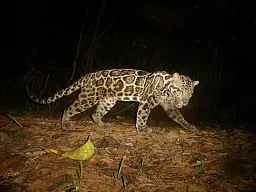Bornean Clouded Leopard
Species Facts
The clouded leopard found on the islands of Borneo and Sumatra has been determined to differ genetically from the species found in mainland Southeast Asia. It is, in other words, a new species of cat. Research made public in 2007 clearly shows the Bornean cat to be as different from the mainland species as is, for instance, a tiger and a jaguar.
- Scientific Designation: Neofelis diardi
- Endangered Status: Vulnerable (VU)
Profile
The Bornean clouded leopard has small cloud markings, many distinct spots within the cloud markings, gray fur, and a double dorsal stripe. The coloration of this new species is darker than the mainland species. The mainland species, by comparison, is characterized by large cloud patterns on the fur, with fewer spots within the cloud markings. The spots are often faint. The mainland clouded leopard has a tendency toward tawny-colored fur and a partial double dorsal stripe.
Borneo’s most fearsome predator, the clouded leopard has the longest canine teeth of any feline. Fully-grown adults can have fangs that are up to two-inches long. Furthermore, tails that equal their body length allow these secretive and solitary creatures to balance in trees, where they perch waiting to pounce on their prey.

Species Distribution
Within its range on Borneo and Sumatra, the Bornean clouded leopard occurs in the most forested habitats of Borneo, from coastal areas to the interior mountain ranges. Their preferred habitats are dense lowland and hill forests. The species usually avoids open areas with few trees and is very sensitive to human disturbance. Little is known about the behavior and ecology of this secretive animal. The agile body, short legs, large paws, sharp claws, and superior climbing ability enable the Bornean clouded leopard to reside and stalk high in trees and take down a variety of prey. These cats feed on monkeys, deer, and pigs. Occasionally they will hunt and eat birds and reptiles.
Distribution map courtesy of IUCN (International Union for Conservation of Nature), compiled in 2015.

Clouded Leopard Traveling in Borneo
Threats to the Bornean Clouded Leopard
Population estimates for the Bornean cat vary greatly (5,000 to 11,000 individuals are believed to live on Borneo, and 3,000 to 7,000 on Sumatra). Further studies must be conducted to obtain better population data. Threats to the species include habitat loss, habitat destruction, and hunting of this cat and its prey by humans.
The Bornean clouded leopard is listed by the International Union for Conservation of Nature (IUCN) as Vulnerable (VU). It is protected under appendix I of the Convention on International Trade in Endangered Species (CITES), where it is listed as a synonym of Neofelis nebulosa, the mainland species.
Want to help us research and conserve this species?
Felidae Conservation Fund helps researchers around the world study and protect felids of all sizes.
Make sure you write a comment with "Bornean Clouded Leopard" so we can designate 100% of your donation to go to protecting this species.
Do You Have 2-4 Hours A Month To Preserve Your Local Ecosystem?
Our volunteers are the driving force behind making true change in ecosystem health and wild cat conservation. Some like to volunteer in the field, others help us maintain our online presence, and some work with events. With just a few hours a month, you can make a difference, too.
Make A Difference Right Now
As a 501(c)3 nonprofit, our work is only possible because of generous donors like you.
More than 90% of your donation will go directly to our groundbreaking research, outreach, and education programs.
This is where true change starts. If you’d like to be a part of it, make a donation to Felidae Conservation Fund today:
Or,

